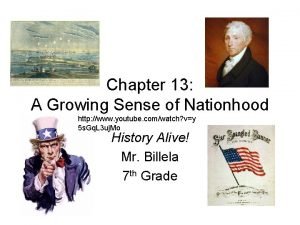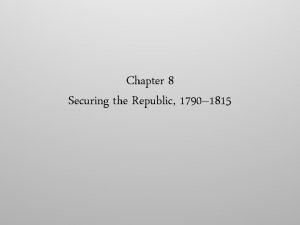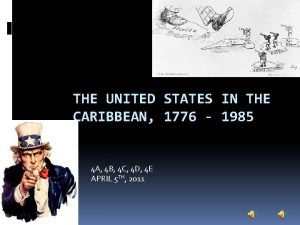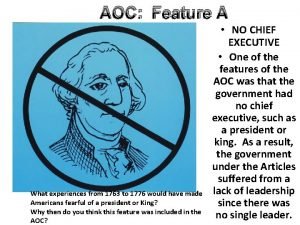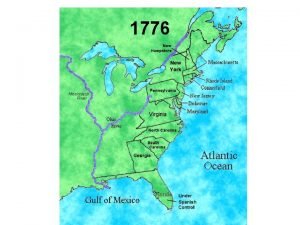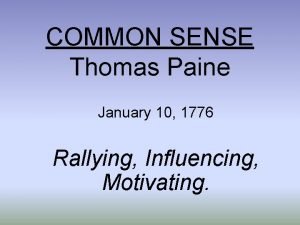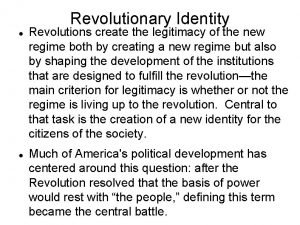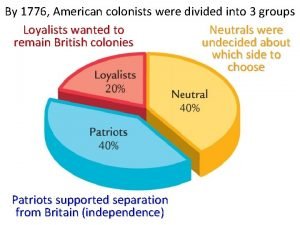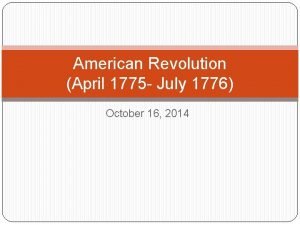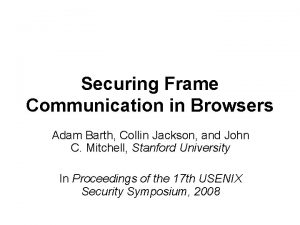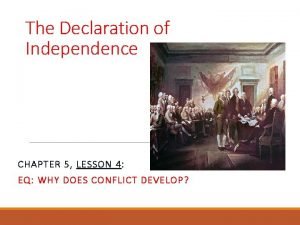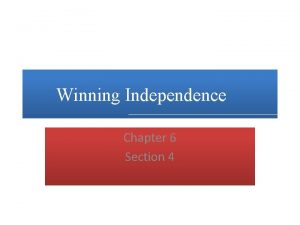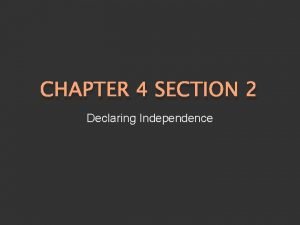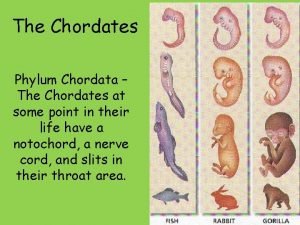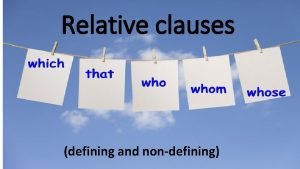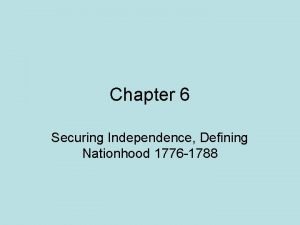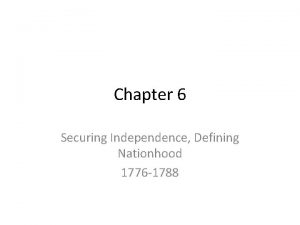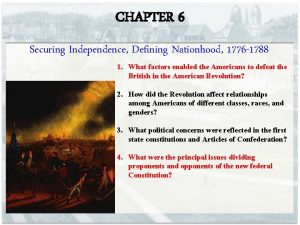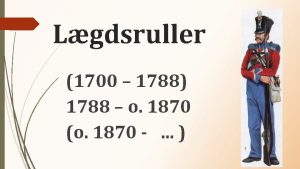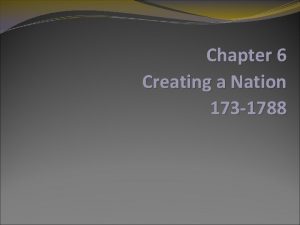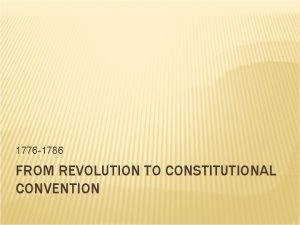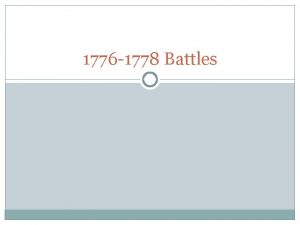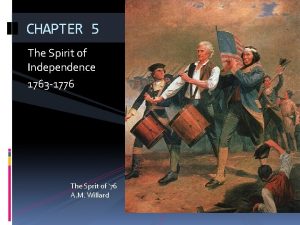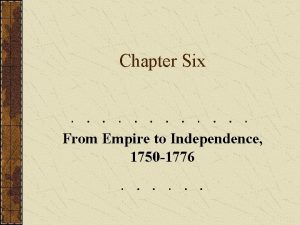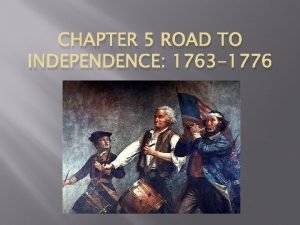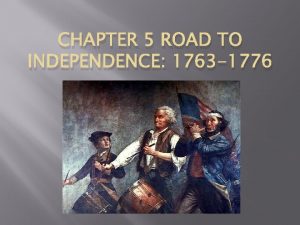Chapter 06 Securing Independence Defining Nationhood 1776 1788





















































- Slides: 53

Chapter 06 Securing Independence, Defining Nationhood, 1776 – 1788

Readings for Chapter 6 • You MUST read pages 166 -184 • I will only cover the Revolutionary War in this chapter and a few “interesting” stories about ratification of the Constitution. • Read also, page 153, 160 -161 and 175. • Be prepared for a quiz along the way. • Reading is FUN de mental! 2

The Prospects of War Loyalists and Other British Sympathizers

The Opposing Sides Britain 11 million 111, 000 soldiers to 162, 000 30, 000 Hessians 21, 000 Loyalists *expenses strained economic resources National debt doubled Over 100, 000 sailors 62, 000 lost Americans Citizen soldiers (state militia) Not trained in Continental fighting (guerrilla tactics) Need for precise execution of movements and mass formations Discipline and training lacking 220, 000 troops Washington -- logical choice --bad military reputation 4

Battle of Quebec December 1776 • • • Benedict Arnold Marches north with army Besieges city Wounded in the knee Battle lost National hero 5

American Navy • • • John Paul Jones 1779 Bonhomme Richard 42 guns HMS Serapis 20 guns Battle of Flamborough Head Jones’ ship was burning and he should have struck his colors, but he yelled his immortal works, “I have not yet begun to fight. ” • Serapis surrendered and Jones transferred his colors. • Repairs were made in Holland to the USS Alliance. • John Paul Jones became a legend. 6

Shifting Fortunes in the North, 1776 -1778 • New York • • • Summer of 1776 General William Howe 32, 000 troops Admiral Richard, Lord Howe 130 warships Battle of Brooklyn Heights August 27, 1776 ¼ of Washington’s troops killed or captured British prison ships Washington’s retreat across New Jersey and the Delaware River Thomas Paine: “These are the times that try men’s souls. ” New Jersey loyalists ruin the state 7

Valley Forge • • • Shelters Forests depleted No food No sanitation No shoes No clothes Desertion rate high Thomas Paine Washington needs to take action! 8

Washington Strikes Back • Christmas night 1776 • “The Crossing” of the Delaware • Battle of Trenton New Jersey • Captured 918 Hessians • Hessian commander killed by sharp shooter • Lost 4 Continental soldiers • January 3, 1777 • Battle of Princeton • 1, 200 British captured 1/3 Lost 40 men • New Jersey’s loyalists jailed and killed by militia 9

Map 6. 1: The War in the North, 1775– 1778 10

The Marquis de Lafayette • • • Lafayette, Georgia Fayette, Alabama 20 years old Aristocrat Joined Washington’s staff Brave Idealistic Optimistic Maybe France will join the cause King Louis XVI wanted proof of American ability 11

Battle of Brandywine Creek September 11, 1777 • • General William Howe Landed 18, 000 troops near Philadelphia Washington occupied Philadelphia with 16, 000 men August 1777 • Continental units crumble • Howe takes Philadelphia • Washington strikes back • Germantown, Pennsylvania • • • October 4 Washington is a LOSER again! Washington had lost 20% of his army wounded, killed or captured Many called for Washington’s resignation Only his Masonic brothers stayed loyal to him This held the army together 12

Battle of Saratoga October 17, 1777 • • • British 2 pronged attack Drive a wedge Cut off the New England states • • Lt. Colonel Barry St. Leger From Fort Oswego 750 Colonials at Fort Stanwix Couldn’t take the fort in 3 weeks Retreated in August 1777 • • • General John Burgoyne Main British army 8, 300 men and Hessians Recaptured Fort Ticonderoga and Crown Point General Horatio Gates with 7, 000 men 2 Battles make up Battle of Saratoga Burgoyne surrendered TURNING POINT 13

Baron Friedrich Wilhelm von Steuben • February 1778 • German soldier of fortune • Short, squat, immensely popular • Tantrums of swearing German, French, English • Administrator and genius • Single-handedly turned army into a formidable fighting force • Died a bachelor 14

Battle of Monmouth June 28, 1778 • France entered the war on America’s side. • Thousands of troops needed to fight against France in the West Indies • General Henry Clinton (new commander-in-chief of British forces) • Withdraws from Philadelphia • Colonial Army catches REAR GUARD in New Jersey • 6 hour battle 100 degree heat • Clinton broke off contact, “My Lord, you must heed the voice of God. ” • British slipped away in the night for New York. • Whig militia in New Jersey “exterminated” loyalists. • Battle for the north was over. 15

“Molly Pitcher” • Nickname given to a woman that said to have fought in the American Revolution. • Believed to have been Mary Ludwig Hays. • Historians regard Molly Pitcher as legend rather than history. Molly Pitcher may be a composite image inspired by the actions of a number of real women. • name originated as a nickname given to women who carried water to men on the battlefield during the war. • Affected outcome of Monmouth due to heat. 16

War in the “South”West, 1776 -1782 • Cherokee Wars – Cherokees attacked settlers in N. Carolina – Colonial retaliations – Burned most Cherokee towns – Cherokees signed treaties surrendering most of their lands to S. Carolina, N. Carolina and Tennessee 17

War in the “North”West • • • Ohio Indians fought white settlers in Kentucky Battle of Vincennes “Ven” “Sin” Colonel George Rogers Clark – 175 Kentucky militiamen – Captured lost and retook former French town Shawnee John Bowman May 1778 Delaware and Mingo Daniel Brodhead August 1778 18

Mohawk Joseph Bryant • • • Chief Iroquois and Mohawk Pennsylvania and New York frontiers 1778 700 settlers killed General John Sullivan Retaliated 3, 700 Colonial troops Battle of Elmira, New York Artillery routed Bryant’s warriors 24 Iroquois villages burned Iroquois fled into Canada Many starved as 60 inches (5 feet) of snow fell 19

Significance • Quenching Indian resistance would impact the future shape of the United States. 20

Map 6. 2: The War in the West, 1776– 1782 21

Victory in the South • British assault on Fort Moultrie – Defends Charles Town – British Admiral Sir Peter Parker – Shattering cannon fire from ships – Patriot’s blue battle flag – Flagstaff shattered – Sergeant William Jasper – Retrieved / cannonbore pole – Drove into rampart / inspired men – Refused commission as officer (illiterate) – Killed in Battle of Savannah, Georgia Oct. 9, 1779 22

General Augustine Prevost Captured Savannah from the Americans Asked to retire Replacement was captured Remained in command through the Siege of Savannah 23

Jasper, Alabama connection • Dr. Edward G. Musgrove • Settled in 1815 • Named town in honor of Revolutionary War hero • Sergeant (Sgt. ) William Jasper – No, Jasper never came to Jasper. – *This was a trend up until the U. S. Civil War. 24

Jasper later rescued 12 American prisoners from the British at a site that became known as Jasper Springs. General Count Casimir Pulaski killed at Savannah. Jasper got a sword. Pulaski got a 25 fort.

Sergeant William Jasper Bronze relief on monument 26

Fort Pulaski Savannah, Georgia 27

Map 6. 3: The War in the South, 1778– 1781 28

War in the South • British Strategy – Secure Southern ports – Gain flexibility to move troops back and forth from colonies to West Indies – General Henry Clinton – Loyalist militiamen would be used – Counted on Tories to come to their aid – Then, bickering in UK caused 2 year delay 29

Georgia and Alabama • • • 1778 Troops from East Florida took Georgia Alabama Fort Charlotte (Fort Conde) in Mobile Spain entered war on side of Colonists Brigadier General Don Bernardo de Galvez Landed at Choctaw Point Placed 6 batteries of artillery north and west of fort “Brisk cannonade” which lasted two weeks March 13 or 14, 1780, Captain Elias Durnford surrendered Small garrison of Scottish kilted highlanders marched out 30

War in the South continued… • • • General Henry Clinton 9, 000 men Charles Town, South Carolina 3, 400 man garrison Surrendered Problems – Cherokees on war path – Loyalists had given up 31

Sacred to the Memory Swamp Fox of GEN. FRANCIS MARION Who departed his life, on the 26 th of February, 1795, IN THE SIXTY-THIRD YEAR OF HIS AGE Deeply regretted by all his fellow citizens HISTORY will record his worth, and rising generations embalm his memory, as one of the most distinguished PATRIOTS AND HEROES OF THE AMERICAN REVOLUTION which elevated his native Country TO HONOR AND INDEPENDENCE, AND Secured to her the blessings of LIBERTY AND PEACE This tribute of veneration and gratitude is erected in commemoration of the noble and disinterested virtues of the CITIZEN; and the gallant exploits of the SOLDIER; • Francis Marion • Militia • Dealt British misery 32 Who lived without fear, and died without reproach

War in the South continued • • General Horatio Gates (militiamen) General Lord Charles Cornwallis American Victories Kettle Creek Cowpens Eutaw Springs Kings Mountain 33

War in the South continued • • • Battle of Camden Worst Colonial defeat of the war Battle of Guilford Courthouse Gates relieved of command after Camden General Nathaniel Greene takes command • Writes to Washington “We fight, get beat, rise and fight again. ” • This is what Washington needs. • Cornwallis moves north • Militia breaks supply lines • Cornwallis holds up at Yorktown 34

Battle of Yorktown • August 30, 1781 until October 19, 1781 • French fleet arrives • Drops anchor off Virginia and won’t allow Cornwallis resupply • Washington moves south • French army lands • La. Fayette joins Washington • 6, 000 British against 8, 800 Americans and 7, 800 French • Cornwallis surrenders • George III has given him powers unprecedented to negotiate. So, this proves to be the end. 35

Peace at Last, 1782 -1783 • • Cornwallis was a god to British people. Overtaxed people order peace terms John Adams, Ben Franklin, John Jay Treaty of Paris, 1783 – – Withdraw British troops Britain returned Florida to Spain 31 Parallel set as boundary British debt could not be collected so Britain held on to some forts – No provision for Native Americans – 5% of all free males had died fighting British 36

The Revolution and Social Change Egalitarianism / White Men Read

White Women in Wartime • Read 38

Revolution for African-Americans • Read 39

Native Americans and the Revolution • Read 40

Forging New Governments, 1776 -1787 From Colonies to States

Formalizing a Confederation, 17761781 • See Articles of Confederation Slide Show 42

Finance, Trade and the Economy, 1781 -1786 • Read 43

The Confederation and the West • Read 44

Map 6. 4: State Claims to Western Lands, and State Cessions to the Federal Government, 1782– 1802 45

Toward a New Constitution, 1786 -1788 Shay’s Rebellion, 1786 -1787

Map 6. 5: The Northwest Territory 1785– 1787 47

Shay’s Rebellion 1786 -1787 • • Massachusetts farmers Legislature: Pay of war debt in 3 years Tax hike Shortage of gold and silver coin (specie) Daniel Shays Marched on Arsenal at Springfield Militia gained control and put down rebellion 48

Annapolis Convention • Delegates from 5 states • Called for a general convention to amend the Articles of Confederation • Congress asked states to appoint delegates to meet in Philadelphia. 49

The Philadelphia Convention, 1787 50

Struggle over Ratification 51

Map 6. 6: Federalist and Antifederalist Strongholds, 1787– 1790 52

Conclusion 53
 Chapter 13: a growing sense of nationhood answer key pdf
Chapter 13: a growing sense of nationhood answer key pdf Nondefining
Nondefining Relative clauses defining and non defining
Relative clauses defining and non defining Relative clauses defining and non defining
Relative clauses defining and non defining Defining relative clause meaning in telugu
Defining relative clause meaning in telugu Adjectival clauses
Adjectival clauses Relative clause definition
Relative clause definition Chapter 8 securing information systems
Chapter 8 securing information systems Chapter 8 securing information systems
Chapter 8 securing information systems Chapter 8 securing information systems
Chapter 8 securing information systems Chapter 8 securing the republic summary
Chapter 8 securing the republic summary Chapter 8 securing information systems
Chapter 8 securing information systems Chapter 8 securing information systems
Chapter 8 securing information systems The united states in the caribbean 1776-1985
The united states in the caribbean 1776-1985 13 colonies population 1776
13 colonies population 1776 Ccc1776
Ccc1776 What experiences from 1763 to 1776
What experiences from 1763 to 1776 1776-1607
1776-1607 What is the significance of july 4 1776 brainpop
What is the significance of july 4 1776 brainpop David hume of the standard of taste summary
David hume of the standard of taste summary January 10th 1776
January 10th 1776 01 ssc 1776
01 ssc 1776 July 12 1776
July 12 1776 1787-1776
1787-1776 1776 divided by 3
1776 divided by 3 July 16 1776
July 16 1776 Securing the human
Securing the human Securing information systems
Securing information systems The most common form of securing channels is through
The most common form of securing channels is through Securing network devices
Securing network devices Securing information systems summary
Securing information systems summary Securing frame communication in browsers
Securing frame communication in browsers Securing frame communication in browsers
Securing frame communication in browsers Securing windows 7
Securing windows 7 Securing
Securing Securing windows 7
Securing windows 7 Client draping
Client draping Securing the northwest territory
Securing the northwest territory Adam secure browser
Adam secure browser Latin american peoples win independence chapter 8 section 1
Latin american peoples win independence chapter 8 section 1 Lesson 4 declaring independence
Lesson 4 declaring independence Lesson 2 uniting for independence
Lesson 2 uniting for independence Chapter 6 section 4 winning independence
Chapter 6 section 4 winning independence Chapter 4 section 2 declaring independence
Chapter 4 section 2 declaring independence Definition of intelligence
Definition of intelligence The defining moment in greek history is the
The defining moment in greek history is the Alligator phylum and symmetry
Alligator phylum and symmetry Problems with conflict theory
Problems with conflict theory Romeo and juliet act 4 summary
Romeo and juliet act 4 summary Lady montague defining quotes
Lady montague defining quotes Non-defining relative clauses as sentence modifiers
Non-defining relative clauses as sentence modifiers Definitions of poverty
Definitions of poverty Symbol defining statements in assembler
Symbol defining statements in assembler 15.1 defining and evaluating a logarithmic function answers
15.1 defining and evaluating a logarithmic function answers
